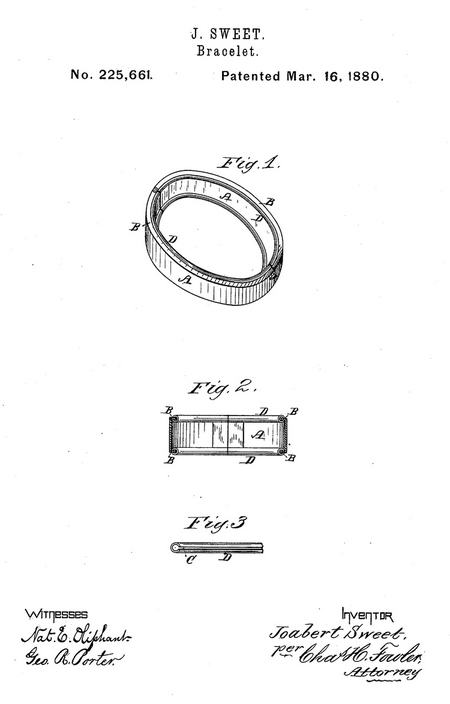Joabert Sweet
- Born: 1 Oct 1818, Attleboro MA
- Marriage (1): Elizabeth Nelson on 9 Feb 1846 in Attleboro MA
- Died: 26 Dec 1898, Attleboro MA
General notes:
Jeweler
Events in his life were:
- He appeared on the census in 1855 in Attleboro MA. Listed as a die-sinker.
- He appeared on the census in 1860 in Attleboro MA. Listed as a die-sinker.
- He appeared on the census in 1870 in Attleboro MA. Listed as a jeweler.
- He appeared on the census in 1880 in Attleboro MA. Listed as a jeweler.

- He was issued patent number 225,661 on 16 Mar 1880
JOABERT SWEET, OF ATTLEBOROUGH, MASSACHUSETTS.
BRACELETS.
SPECIFICATION forming part of Letters Patent No. 225,661, dated March 16, 1880. Application filed December 2, 1879.
To all whom it may concern:
Be it known that I, Joabert Sweet, of Attleborough, in the county of Bristol and State of Massachusetts, have invented a new and valuable Improvement in Bracelets, &c.; and I do hereby declare that the following is a full, clear, and exact description of the construction and operation of the same, reference being had to the annexed drawings, making a part of this specification, and to the letters and figures of reference marked thereon.
Figure 1 of the drawings is a representation of a perspective view of a bracelet embodying my invention. Fig. 2 is a sectional view of the same. Fig. 3 is a detailed view of a section of hollow wire or tubing constructed according to my invention.
The present invention has reference to the manufacture of bracelets and various other articles of jewelry, and has for its object to cover or conceal the exposed edges.
Previous to my invention these edges of the band or plate composing the article of jewelry were bound around by a grooved wire, into which the edges entered, whereby they were concealed, thus forming a finished border and dispensing with the usual lining. Although this ornamental and finished appearance of the edges of the piece of jewelry was effected, there were many objections to this solid grooved sectional wire, from the fact that it required great skill and nicety in making the groove in order to make a perfect joint or connection between the edges of the band or plate and the wire. A further objection was the great amount of material required to produce this solid grooved wire, which would also add unnecessary weight to the article.
It is therefore the purpose of the present invention not only to remove the above objections by securing lightness in the article of jewelry with economy of material, but greatly to reduce the cost of their manufacture, and render the wire or substitute therefor more readily and easily applicable to the edges of the band or plate.
The invention consists in a tubing having a longitudinal groove therein for the reception of the edges of the band or plate composing
the article of jewelry, as will be hereinafter more fully described.
In illustrating the application of my invention I have shown one article of jewelry, consisting of a bracelet, A, whose halves are connected together by the ordinary hinge and clasp.
The bracelet A, which consists of an annular band, has its edges bent inwardly and at right angles, as shown at B. These edges B are inserted in a groove, C, of a tubing, D, and afterward said tubing is secured in place around the edges B by solder or any other suitable means of fastening employed in the jewelry trade.
The shell or body of the bracelet may be formed with its flanges or edges turned outwardly, or in an opposite direction to that shown, and the tubing applied as hereinbefore described; or the flanges or bent edges may be dispensed with, as found desirable.
It will be seen that the groove C does not require so much care in its formation as would be the case were the tubing solid, the edges B, when inserted in the groove, forcing the tubing apart sufficiently to make a neat joint, while the lightness of the tubing and the comparatively small amount of material required to produce it greatly lessen the cost in the manufacture of such articles of jewelry, as well as diminish the amount of skill required in their production.
Having now fully described my invention, what 1 claim as new, and desire to secure by Letters Patent, isó
The tubing D, formed with the groove C, in combination with the edges of the band or outside plate of a bracelet or other article of jewelry, substantially as and for the purpose set forth.
In testimony that I claim the above I have hereunto subscribed my name in the presence of three witnesses.
Joabert Sweet
Witnesses:
John Daggett
Charles O. Sweet
James N. Sweet
Joabert married Elizabeth Nelson on 9 Feb 1846 in Attleboro MA. (Elizabeth Nelson was born on 30 Apr 1810 and died on 23 Feb 1877 in Attleboro MA.)
|

